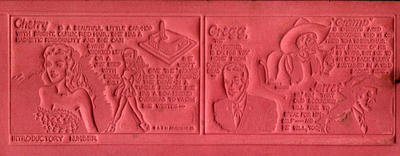
I'm requesting your assistance today. I recently purchased a large batch of printing forms for an ad comic strip called Cherry. While I can (barely) make out the strip on these intaglio cardboard plates (see above), it would be nice to get this collection into some more readable form.
Now my very shaky understanding of the printing process tells me that these little cardboard forms would probably be filled with a thin covering of molten lead. The image would transfer to the lead and then that hardened lead would be used as the printing plate. Have I got that right? If so, I may be stuck already since the idea of working with molten metal is a bit worrisome.
I tried scanning one of these and playing around with contrast etc. and I can get them a bit more readable, but still a long way from crisp linework.
So, can anyone provide suggestions for turning these little cardboard doohickeys into legible black-and-white strips?
Very interesting - I thought all strips were hand drwan. guess not. very cool though. How many did you purchase of these?
ReplyDeleteThe art was originally hand drawn. The syndicate/publisher/distributor uses it to make plates such as these that can be sent around to newspapers. The newspaper uses these forms to create metal printing plates. Of course, all this was before computers made all that guff unnecessary...
ReplyDeleteThey're called matrix, Mats for short. They were sent to the paper along with a quality proof so the printer could tell what they were supposed to look like.
ReplyDeleteThere were several ways of pouring them,all pretty much alike. My first job at a newspaper, after school, was sweeping up, running simple jobs on a small platen press, recycling the printers alloy in what was called a hellpot.
We dumped all the scrap into the pot which kept the alloy at a melting point. I skimmed the crud off the top, poured pigs for the linotypes, and clamped the mat into place, adjusted for size, and poured in the alloy by opening a tap. The result was called a stereotype. The mat could be used a number of times, so if a steretype went bad we could replace it. All kinds of graphics came this way, including clip art. There were also plastic forms that worked much the same way, but allowed for greater resolution. They were still in use about 35 years ago.
They were made by a press that forced the damp cardboard down onto a zinc engraving.
About the only way to get a good imaqge would be to pour something into them, then roll the top with an ink and press them onto paper.